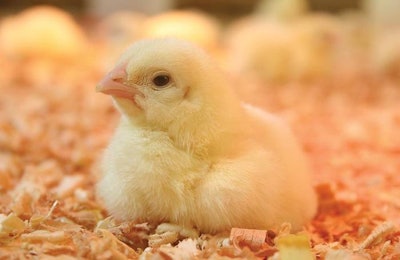
This article appears in the July issue of Poultry International. View all of the articles in the digital edition of this magazine.
We have already discussed the reasons and benefits from using a super pre-starter broiler formula during the first seven days post-hatch. We have also deliberated about ingredients that make such formulas so special, giving them that extra boost young chicks require early in life. But, placing all these together remains top-secret among nutritionists, most likely because this technology is so brand new. It does not have to be so, and here we will talk about these formulas, giving a real-life example.
Real-case formulas
The formulas presented in Table 1 are generic ones based on real-case scenarios from customers raising broilers on large scale in Europe and elsewhere. The conventional formula, a typical pre-starter fed for seven days post-hatch, is indeed a heavily fortified diet. It is not as high on energy, as some nutritionists might suggest, but it is sufficient in amino acids, and all other vital nutrients.

Table 1 shows two actual formulas used under European commercial conditions to test the efficacy of a super pre-starter broiler feed over a conventional one.
In this particular formulation, we have used a typical antibiotic plus anti-coccidial approach, and, as such, it is not ready for a program devoid of these compounds. The new formula, the super pre-starter, is formulated to similar nutrient levels with the only difference being the use of highly digestible protein sources (animal plasma and soy protein concentrate). Animal plasma promotes gut health and feed intake, whereas soy protein concentrate is a dense source of highly digestible amino acids. Other specialty ingredients may be added, all proteins at the expense of soybean meal, but there is a cost limit. The last diet is one that uses no in-feed growth-promoting additives. Instead, it depends on enzymes, organic acids and phytogenic compounds to replace antibiotics; but still a coccidial preparation is used. Please note that these formulas are generic examples, as each specific farm will require customization to suit genetics, health status, facilities, ingredients and targets. They are presented here for discussion purposes only.
Field performance that pays for the extra cost
When such formulas are used under commercial conditions, results can be satisfactory to exceptional — in any case, more than enough to pay for the extra cost. I will bring to your attention results obtained by a commercial integrator in Europe. There, a customized form of the conventional and super pre-starter diets presented in Table 1 were fed followed with typical starter and grower diets until slaughter. As can be seen in Table 2, after two batches of broilers were tested, the conventional diet did a very good job. The performance is comparable to many modern farms using similar genetics and nutrition programs. But, as expected, the super pre-starter gave birds an early advantage that lasted until market age. Broilers fed the super pre-starter for the first seven days post-hatch were (on average, for two batches):
- 60 grams heavier at market age
- More efficient in converting feed to meat by eight points
- Less costly to feed despite the extra cost of the super pre-starter
- More efficient in using available surface
- More profitable by 7 euro cents per bird

Table 2 shows the results from feeding a super pre-starter broiler formula versus a conventional one for the first seven days post-hatch in a European commercial facility.
It might look surprising that such small changes in feed formulation for such a small period of time can have such an impact throughout the commercial life of a broiler, but those who deal with young animal nutrition can attest to this phenomenon: an investment in early nutrition pays good dividends at the end. This is true not only for broilers, but also for piglets and calves.
Further improvements to formulas
Ideally, the super pre-starter formula would contain even less soybean meal and more of purified proteins, such as soy protein concentrate or wheat gluten, for example. The exact amount for wheat gluten can range from 2 percent (Europe and the U.S., where it is more expensive) up to 10 percent (Asia, where it is relatively inexpensive). Again, this is an area where each formulator will have to find the balance between cost and benefit. Perhaps, some fishmeal could further improve this formula, but this remains to be seen.
An investment in early nutrition pays good dividends at the end.
Also, I would have liked to see total crude protein reduced to avoid the problems of excess dietary protein that "robs" broilers of performance potential, but this is my personal preference. This recommendation is even more pertinent when traditional growth promoters (antibiotics) and anti-coccidials are excluded. In such case, it is almost imperative to keep crude protein as low as possible and organic matter digestibility as high as possible to avoid overloading the hindgut with all kinds of nutrients that can be used by pathogens to cause digestive upsets.
Pushing to the extreme
Naturally, when a little bit of good is desirable, a lot more cannot harm, right? Perhaps, adding such specialty ingredients in grower and, why not, finisher broiler diets, can confer even further improvements in performance and profitability. This is not an unreasonable assumption by those who first encounter the benefits of early nutrition. Experiences from other species have shown that the return on investment diminishes very rapidly, and, as such, it is best to place the "weight" early on. It might be so that having a super pre-starter even more fortified and expensive than the one presented here be sufficient for only four days post-hatch, but again, we have lots of research ahead of us. Of course, this position is not applicable for ingredients that replace antibiotics. In any case, this is an exciting new frontier for nutritionists who specialize in early nutrition.

















